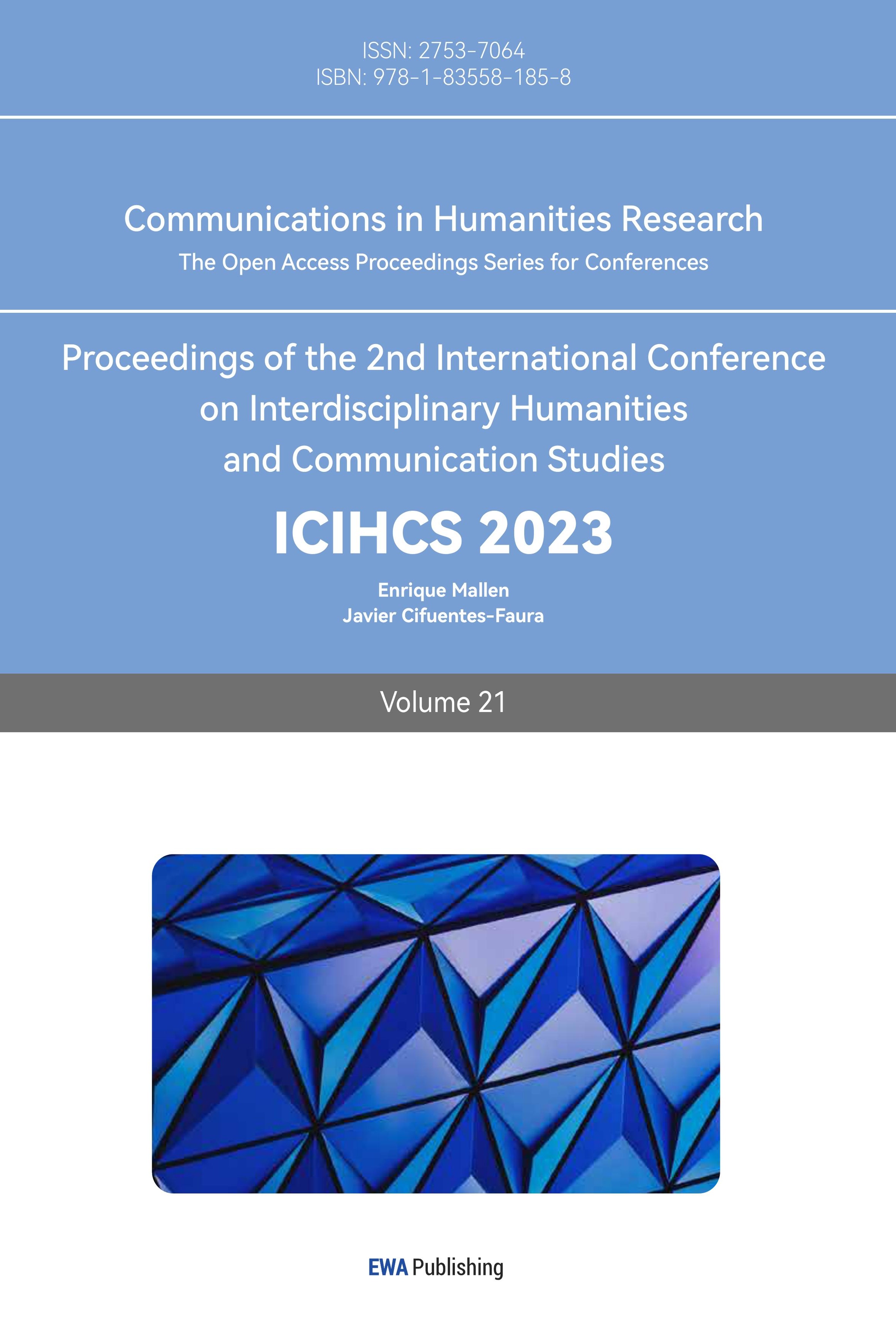1.Introduction
Prosody is the core of oral production, perception, and comprehension [1], of which the coding of prosodic hierarchy system and focus encoding are two important processes. The prosodic hierarchy system, prosodic boundary is an organizational framework that divides speech flow into different levels of speech chunks [2-3]. Most of the research on Mandarin prosody is based on the prosodic hierarchy model C-ToBI proposed by Li [4]. Based on C-ToBI, Yin checked the characteristics of continuity and discontinuity effects at the boundaries of each level, proposing that continuity is responded by the change of pitch value, and discontinuity corresponds to syllable duration, pause and pitch reset [5]. Previous studies on the discontinuity effect and continuity effect at prosodic boundaries have shown that as the level of prosodic boundaries increases, the level of perceived discontinuities increases accordingly [6][4][7].
In terms of focal stress, it is a means to reflect new information [8]. Wang et al. pointed out that the most prominent accent in a sentence to express focus is called focus accent, and the focus accent in Mandarin is related to semantic salience [9]. Since the focus stress share the same acoustic manifestations with the boundary effect, it is very possible that they would interact and influence each other during the process of sharing speech resources.
Although the cross-interaction between focal stress and prosody boundaries has long been investigated by previous researchers, this remains a point of scholarly growth in Yin ‘s view [5]. Chen found that there is a spill-over effect caused by focal stress because the magnitude of the growth is constrained by the type of the boundary of the focal domain [10]. Wang, Xu &Ding proposed an independent encoding system where focus works dependently from prosody hierarchy boundary system in Mandarin Chinese, i.e., the former is dominated by pitch range modulation, and the latter is dominated by duration modulation [11]. The study of narrow-focused accented speech performance by Lin also showed that the encoding of focus is dominated by pitch accentuation [12]. On this basis, Liu and Wang further pointed out that the weakening effect caused by prosodic boundary levels on the effect of focus encoding occurred under specific prosodic boundaries and stress conditions [13]. Qin argues that contrastive focus relies more on the negative reduction of intonational elements of non-focused components (pitch reduction, tonal range narrowing, shortening of tone length and reduction of tone strength), and that such means form a dominant falloff from the focus part to mark the focus information [14]. Although Qin’s view needs to be further confirmed by placing the contrastive focus in a different prosody environment, he has already pointed out that the speech resources allocated to the contrastive focus as new information highlighting are in competition with the original prosody hierarchical encoding, which is at odds with the mutual independence of the focus and prosody structural encoding proposed by Wang et al [9]. If it is collaborated with that of Liu Lu et al.’s [13], it could be found that focal stress and prosodic boundaries are not encoded in parallel, which also needs to be verified by considering different boundary levels and different locations of foci.
Therefore, the interaction between boundaries and foci in natural Mandarin speech would be examined and explored even further, in order to reverse-validate Liu et al.’s proposal that prosodic boundaries and foci are intonationally encoded in parallel [13]. Additionally, this paper further corroborates and complements the validity of the acoustic parameters related to the boundaries and stress attached to narrow focus, which would benefit the field of artificial intelligence, natural language processing and speech recognition.
Following are key questions to solve: 1) Whether both prosodic boundary levels and focus positions significantly affect the discontinuity and continuity effects; 2) Whether changes in focus accent positions at different boundaries would enhance or attenuate the discontinuity and continuity effects; and 3) Whether different boundaries, and different stress positions, would have different effects on the discontinuity effect and the continuity effect.
2.Method
2.1.Design of Materials
As Mandarin is a tonal language, tonal combinations also have an impact on the measurement of these acoustic features found by Li et al. from a perceptual perspective [15]. Therefore, the selected words should share phonetically similarity. In addition, the narrow focus loaded with contrastive information is chosen because it is a more stable and reliable focus environment than wide focus [14]. Therefore, phonetically similar narrow foci are chosen.
The prosodic structure stratification mode and terminology of C-ToBI is adopted as different levels of the two independent variables, one of which is the prosodic boundary level, which can be further divided into four levels, namely PW (prosodic word boundary), PP (prosodic phrase boundary), IP (intonational phrase boundary), and UP (utterance boundary). Another independent variable is the distribution of focus position, and there are five levels in total, which are zero focus (zero), focus before boundary (before), focus overlapping the boundary word (centre), focus after the boundary word (after), and end-of-sentence focus (end).
The experiment controlled two factors, prosodic boundary, and focus, and designed a total of four sets of sentences. Each set of sentences contained four boundary conditions and five focus positions, so there is a total of twenty crossover cases. Each set of sentences had a unique boundary target word, with a total of four target words, namely [niou35 uA55] (bullfrog), [mi51 lu51] (honeydew), [tɕiau55 iɛn35] (Pepper), and [mei35 kuei55] (Rose). The target word X is followed by four boundary types, PW, PP, IP, and UP, respectively. Below are examples of the first set of experimental sentences, and focus stimulus sentences, respectively:
Table 1: Example of contrasting focus stimulus outputs in different positions.
|
Sentence of zero focus: |
|
tʃɑŋ55 thian55 tuən51 tɛ niou35 uA55 xuei51 ʃuan51 tau51 luo35 mei51mei51 tɕiA55 lɛ. Zhang Tiandun’s bullfrog stew has arrived at Sister Luo’s house. |
|
Example of Guide Sentences(Q) & Target Sentences(A): |
|
Q1(PW): |
|
lin35 thian55 tuən51 tɛ niou35 uA55 xuei51 ʃuan51 tau51 luo35 mei51 mei51 tɕiA55 lɛ? Has Lin Tianton’s bullfrog stew arrived at Sister Luo’s house? |
|
A1(PW): |
|
pu51, tʃɑŋ55 thian55 tuən51 tɛ niou35 uA55 xuei51 ʃuan51 tau51 luo35 mei51 mei51 tɕiA55 lɛ. No, Zhang Tiandun’s bullfrog stew has arrived at Sister Luo’s house. |
|
Target Answers: |
|
A2(PP): |
|
pu51, tʃɑŋ55 thian55 tuən51 tɛ niou35 uA55 xuei51 ʃuan51 tau51 luo35 mei51 mei51 tɕiA55 lɛ. No, Zhang Tiandun’s bullfrog stew has arrived at Sister Luo’s house. |
|
A3(IP): |
|
pu51, tʃɑŋ55 thian55 tuən51 tɛ niou35 uA55 xuei51 ʃuan51 tau51 luo35 mei51 mei51 tɕiA55 lɛ. No, Zhang Tiandun’s bullfrog stew has arrived at Sister Luo’s house. |
|
A4(UP): |
|
Pu51, tʃɑŋ55 thian55 tuən51 tɛ niou35 uA55 xuei51 ʃuan51 tau51 luo35 mei51 mei51 tɕiA55 lɛ. No, Zhang Tiandun’s bullfrog stew has arrived at Sister Luo’s house. |
2.2.Speakers and Setup
Four participants (2 males and 2 females) participated in this experiment. All of them were students of East China Normal University whose hometown were all located in northern China, aged between 19 and 25 and their Mandarin was standardized with no obvious accent. None of them were academics majoring in linguistics-related disciplines, and they had never received systematic music training. A small amount of payment will be offered for their participation in the experiment.
The recording was done in the laboratory in the School of International Chinese Studies, East China Normal University. The target sentences were presented in a certain order on the computer screen with the help of the Byly recording program developed by Beijing Language and Culture University. Participants were required to first familiarize themselves with any words that appeared during the experiment and then required to first read aloud the targets, which were used as zero-focus conditions, followed by the researcher starting to guide them to produce negative target answers with narrow contrasting foci. After that, the main test will guide the speakers to produce the target sentences based on different questions in two rounds. Therefore, each pronouncer would produce 4*5*4*2=160 target sentences, which will be averaged after the corresponding acoustic parameters of each target sentence are extracted. The whole process would be done twice and there will be two interference groups, making a total of 832 sound files. The recording equipment used included a Dell laptop, and the recording software used was Praat with a 44100Hz recording sampling rate and the sampling precision is 16-bit, mono. The recording time was about 1 hour.
2.3.Acoustic Analysis
The boundaries of each syllable were first manually labelled and then calculated in phonetic analyzing software Praat with the help of ProsodyPro [16], and the vibration period of the vocal folds was checked. The script was then used to generate a text document containing the information of the pitch maxima, averages, and durations of the syllables before and after the boundaries. The pitch values (Hz) were then converted to semitones (st) using the formula fst=121og2(f0/fref), with 85 Hz as the reference value for females and 50 Hz for males.
The acoustic parameters to be extracted include: the duration of the syllable before the boundary, the pause duration after the boundary, the pitch change before and after the boundary (f0) and the syllable duration before the boundary. To calculate the pitch change, the syllable pitch value after the prosodic boundary is subtracted from the syllable pitch value before the prosodic boundary, that is, f0 (pitch difference) = f0 (after) - f0 (before). The examined data are summarized in an Excel table.
2.4.Statistical Methods
Supported by R 2023 version [17], the experiment first applied two-way analysis of variance (ANOVA) for calculating the main effects and interaction effects, followed by Fisher-LSD for multiple comparisons to look at the differences in the significance of the effect of the corresponding variables between levels of the independent variables. In the final fit using the mixed linear model (lme4), “zero focus” and “PW” were chosen to be the baseline variables. The interaction effects between the two independent variables will also be examined based on the mixed linear model (REML method) and t-tests (Satterthwaite’s method). Therefore, the statistical results include the main effects test and the interaction effects test for the two independent variables.
3.Results
3.1.Discontinuity Effects
3.1.1.Syllable Lengthening Effect
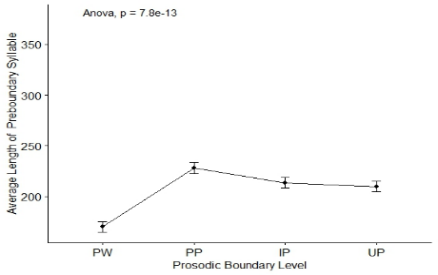
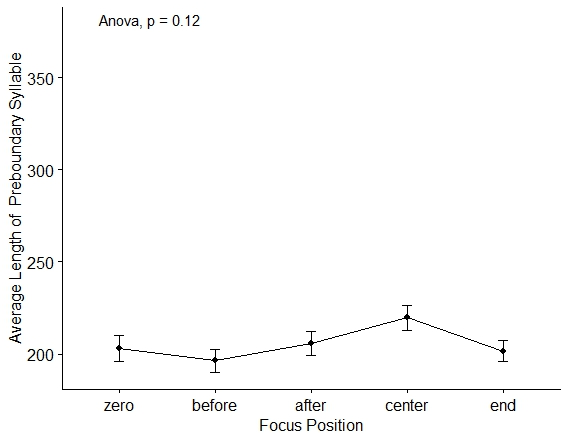
Figure 1: Focus Position, Boundary Level, and Average Length of Pre-Boundary Syllable(ms).
A two-way analysis of variance (ANOVA) reveals that the effect of focal position (F (4, 312) = 2.185, p = 0.0707) on pre-boundary duration was less significant than that of the prosodic boundary level (F(3, 312) = 21.081, p <0.0001), with the former being a weakly significant, and the latter being strongly significant.
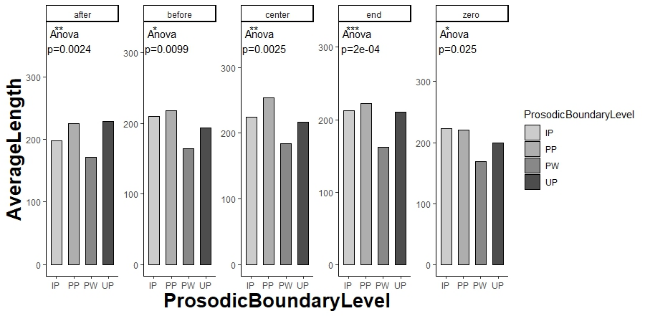
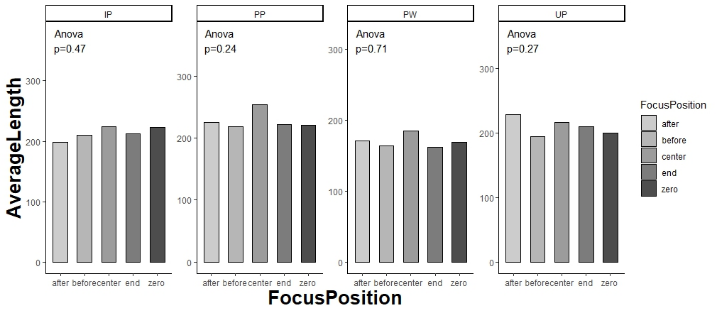
Figure 2: Pre-Boundary Syllable Duration-Using Boundary Level/Focus Position as a Facet Variable.
According to Figure 1 and 2, the overall trend of syllable duration before boundaries is, Tcenter>Tafter>Tzero>Tend>Tbefore, which means centred and after-boundary foci enhance syllable lengthening, while sentence-final foci or before-boundaries weakens syllable lengthening. The general trend of pre-boundary duration is TPP>TIP>TUP>TPW. Syllable lengthening does not correlate positively with the increase in prosody levels. The PP is the most elevated, while the UP boundary is the least. The result support that when the focus is the prosodic word, the discrimination of the pre-boundary syllable duration at PW and others is highly significant (p PW VS PP < 0.0001; p PW VS IP = 0.01797; p PW VS UP = 0.055). Under the effect of sentence-final focus, the syllable duration before the PW boundary is only significantly different from the syllable duration at the higher-level boundary (p PW VS IP = 0.00293; p PW VS UP = 0.00459); Under the effect of before-boundary focus, the discrimination of the syllable duration between PW and UP is significant (p PW VS PP = 0.00136; p PW VS IP = 0.00664).
The above results show that the prosodic boundary level is the key factor affecting the length of pre-boundary syllables. The participation of focus will occupy part of the speech resources.
3.1.2.Boundary Pause Effect
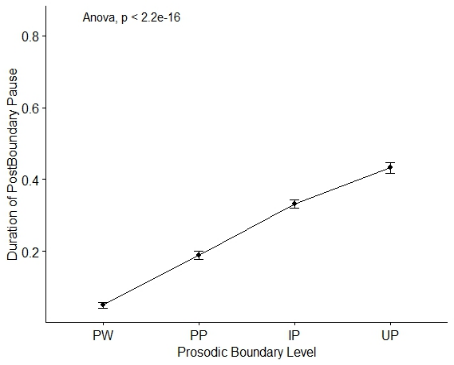

Figure 3: Focus Position, Prosodic Hierarchy, and Average Duration of Post-Boundary Pause.
Two-way analysis of variance shows that the effect of focus position (F (4,312) = 0.5838, p = 0.6746) on pre-boundary duration is not as great as that of prosodic boundary level (F (3,312) = 21.081, p<2e-16). The general trend of the length before the boundary of the strong significant prosodic level is TUP > TIP > TPP > TPW.
According to Figure 3 and 4, although the focus position cannot show the main effect, the significance of the focus position can also be induced under a certain prosodic boundary level (p = 0.029). Focal positions will cause significant differences in the duration of post-PW pauses. The post-
boundary pause duration is significantly reduced. The results of two-way ANOVA show that the post-boundary pause duration remains effectively to distinguish the prosodic boundary levels, and the overall trend is TUP > TIP > TPP > TPW.
The variance analysis shows that all levels of prosodic boundaries are positively correlated with the duration of post-boundary pauses, but the focus position is basically negatively correlated with the duration of post-boundary pauses. For PP, after-boundary and sentence-final position will have a significant increase effect on the pause, while PP is the only boundary condition that is not significant compared with the baseline situation under the mixed linear model analysis, but such significance is highlighted under the focus effect.
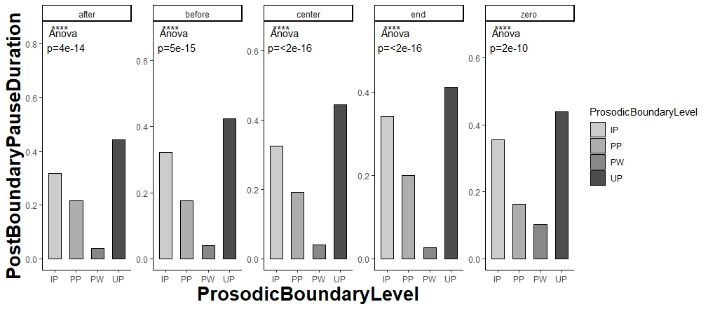
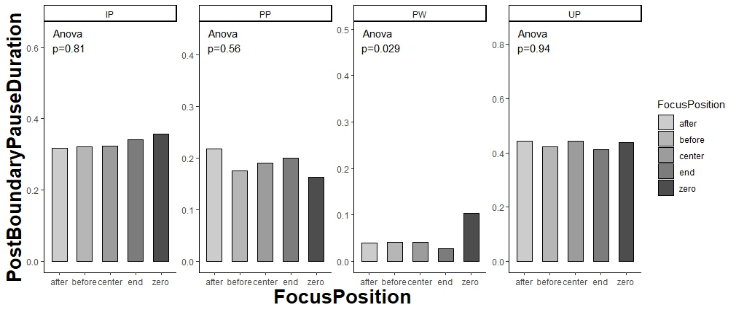
Figure 4: Duration of Post-Boundary Pause- Using Boundary Level/Focus Position as a Facet Variable.
3.1.3.Pitch Reset
Pitch reset means that the original pitch curve of the speech is broken, so that discontinuity is formed. The pitch reset is measured by the pitch difference, which is exactly F=F0 (before)-F0(after). If the result is negative, it indicates that the syllable has a pitch reset, and the larger the negative number, the more obvious the reset phenomenon.

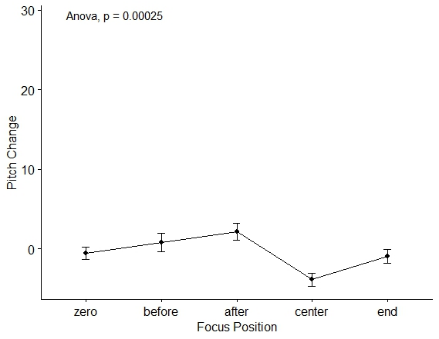
Figure 5: Focus Position, Boundary Level, and Difference in Pitch before and after boundary.
Two-way analysis of variance shows that the effect of focus position (F (4,312) = 2.8071, p = 0.0399) on pre-boundary duration is not as significant as that of prosodic boundary level (F (3,312) = 5.6328, p = 0.0002). According to Figure 5 and 6, the general trend of pitch maximum difference before and after the prosodic boundary is Fafter > Fbefore > Fzero > Fend > Fcenter. When the prosodic boundary is PW and UP, the above types of foci have a significant effect on the pitch reset (pPW = 0.048). pUP = 0.017). The general trend of pitch reset before and after prosodic boundary is FPW > FPP > 0 > FUP > FIP, which means PW and PP are more prone to pitch down tilt, while higher levels maintain better control of pitch reset. Multiple comparison analysis shows that, regardless of IP, PP or UP, there is a significant pitch reduction under the effect of centered focus. The centered focus has the greatest enhancement of pitch reset.
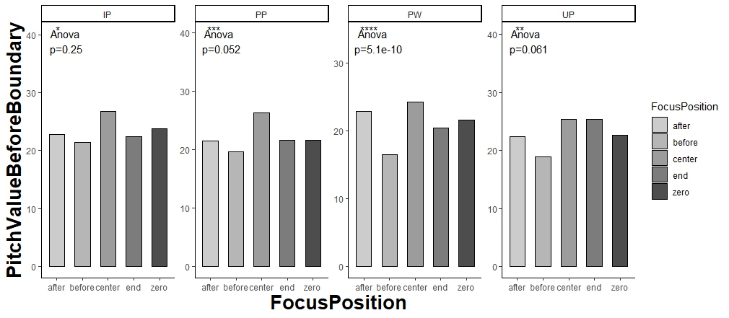
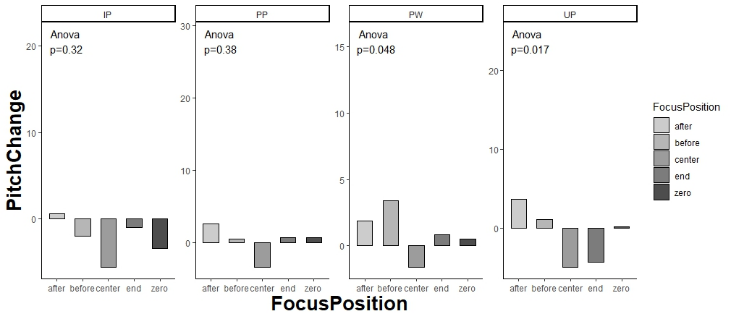
Figure 6: Pitch Resetting-Using Prosodic Boundary Level/ Focus Position as a Facet Variable.
3.2.Continuity Effects
3.2.1.Pitch Reset
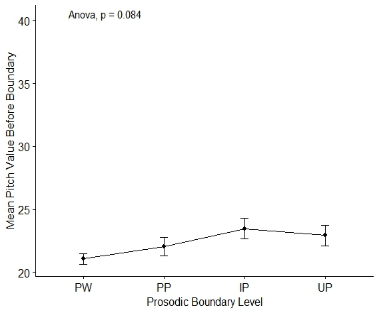
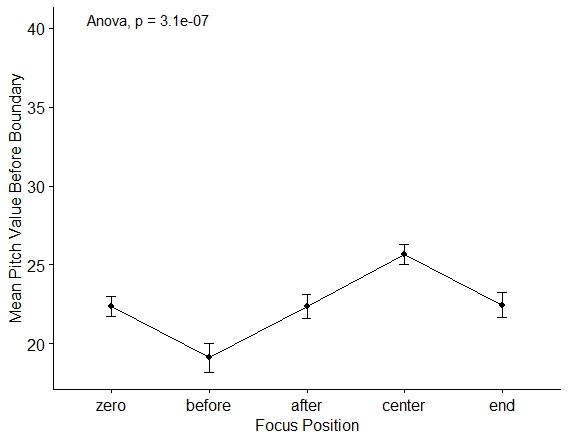
Figure 7: Focus Position, Boundary Level, and Mean Pitch Value Before the Boundary.
The coherence of pitch curve in speech is an obvious continuity effect. Such pitch coherence is generally measured by the pitch value before the prosodic boundary. Yin has found that the larger the value, the better the retention of pitch features before and after the prosodic boundary [5].
Two-way analysis of variance indicates that the focus position (F (4,312) = 3.4957, p = 0.01601) has a significant effect on the pitch before the prosodic boundary, while there is also a strong main effect of the prosodic boundary level (F (3,312) = 13.5393, p < 0.0001 ***). According to Figure 7 and 8, the general trend of the pitch before the boundary is Fcenter > Fend > Fzero > Fafter > Fbefore. When the zero focus is used as the benchmark, the focus at the boundary will increase the pitch before the boundary, while the focus before the boundary will weaken the continuity effect. The general trend of pre-boundary pitch is FIP>FUP>FPP > FPW. Although several boundaries at the higher level have an uplifting effect on the pitch before the boundary, the uplifting effect is not positively correlated with the upgrading of the prosodic level. Among them, the IP boundary uplifts the most, while the PP boundary uplifts the least.
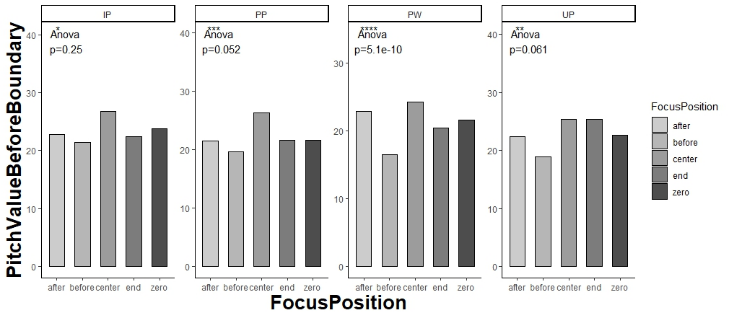
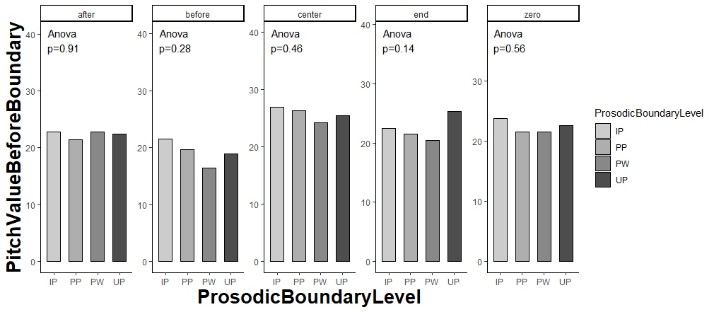
Figure 8: Pitch Value Before the Prosodic Boundary - Using Prosodic Boundary Level/Focus Position as a Facet Variable.
There is no significant difference in the pitch before the boundary of different prosodic levels within the same focus position. The results of multiple comparison analysis show that only IP boundary is significantly different from PW and PP boundary (p IP vs PW = 0.0068; p PP vs IP = 0.0413).
For PW, the pitch before the boundary is significantly affected by the focus position (p = 5.1e-10), and the influence of the focus position is weakly significant in PP and UP. The mixed linear model fitting results show that compared with zero focus, the focus position before the prosodic word at the boundary will significantly reduce the pitch before the boundary (p = 0.00418) and weaken the continuity effect. The multiple comparison results show that the effect of the focus position at the boundary on the pitch in front of the boundary is significantly different from that at other positions. Although the focus at the end of the sentence also plays a lifting role, its lifting effect is not as significant as that of the focus (p = 0.0397). This is because the pitch increment of the focus itself enhances the continuity effect. However, at higher levels of boundary, this effect is often limited.
4.Discussion
Focus and prosodic hierarchy are two sets of independent coding systems, but they share the same resources of intonation. Due to the sharing of resources, they need to cooperate and compete to achieve the balance of intonation. The influence of different focus positions in the prosodic boundary of natural speech on the ‘continuity-discontinuity’ effect is the highlight of this contradiction.
In terms of ‘discontinuity effect,’ the acoustic characteristics at the boundary are mainly controlled by the prosodic boundary level, and the focus environment composed of different positions mainly weakens the control of the boundary level on the acoustic parameters. When the focus is at the boundary and after the boundary, the syllable discontinuity effect will be enhanced. When the focus is at the end of the sentence or before the boundary, the syllable extension will be weakened. Compared with the bottom PW boundary, the higher-level boundary can significantly increase the syllable duration before the boundary and the pause duration at the boundary, but in terms of the effect of enhancement of discontinuity effect, UP is the smallest and PP is the largest, while the pause duration is positively correlated with the level of prosodic boundary.
The participation of focus is a ‘recoding process’. When the focus falls on the prosodic words at the non-boundary, the prosodic boundary target words constitute the non-focus elements, and the focus environment will not only make the difference between the boundary final length of PW and PP and UP with significant differences disappear, but also weaken the control of these boundaries on pause. Furthermore, the focal environment also activates boundaries that were previously insensitive to the length of the pause. For example, the focal environment at different positions enables the PP boundary to be distinguished from the baseline PW level, which is likely to be related to the respiratory mechanism. When the focus falls on the prosodic word at the boundary, it is consistent with the extension of the focus word [13], but this paper further explains that such extension of duration mainly depends on the way of syllable extension rather than the way of boundary pause.
When the prosodic level is higher, the coding effect of the focus environment will be smaller. When the focus environment is before and after the prosodic boundary words, the negative decrement effect of ‘non-focus intonation elements’ will occur, which weakens the pitch reset and even reverses, so that the pitch of the syllable before the prosodic boundary is greater than that of the syllable after the prosodic boundary. If the focus word is located before the prosodic boundary word, the weakening of pitch reset still highlights the position of prosodic boundary level in speech flow, which shows the independence of boundary level relative to focus coding.
In terms of ‘continuity effect’, the acoustic characteristics at the boundary are mainly affected by the focus position. The pitch concerned by the ‘continuity effect’ is also one of the important acoustic parameters to characterize the focus stress. Different from the discontinuity effect, although both the focus position and the prosodic hierarchy can significantly affect the continuity effect, the focus position has a more significant effect on the ‘continuity effect’. It is only possible that the focus environment is directly involved in the pitch processing of the sentence due to the pitch highlighting its own nature. This is reflected in PP, PW, UP, but it cannot get significant effect on IP. The syllable pitch before the IP boundary happens to be the largest in all boundary levels. It is likely that because the IP boundary is just at the boundary of the sentence, the pitch distribution should first consider the tone of the second half, thus weakening the influence of the focus environment.
Consistent with the previous ‘discontinuity effect’, the centered focus or the sentence-final focus, can enhance the continuity effect and increase the pitch value before the prosodic boundary compared with the zero focus, while the focus before and after the boundary seems to constitute a focus field independent of the prosodic environment, which affects the allocation of speech flow resources. In particular, the before-boundary focus significantly weakens the continuity effect.
5.Conclusion
In summary, the acoustic characteristics at the boundary of the prosody are mainly controlled by the
boundary level. The focus environment composed of different positions mainly weakens the effect of the boundary level on the control of acoustic parameters. In terms of ‘discontinuity effect’, the acoustic characteristics at the boundary are mainly affected by the boundary level. In terms of ‘continuity effect’, the acoustic characteristics at the boundary are mainly affected by the focus position. When the focus environment is closer to the target word (but not at the centered position) will compete with the prosodic boundary, weakening the boundary’s control over the continuity and discontinuity effects; the focus environment will also cooperate with the prosodic boundary, activating the boundary that is not sensitive to the discontinuity effect. When the focus falls on the boundary or the end of the sentence, it will cooperate with the boundary, enhancing the discontinuity and continuity effect at the boundary. The prosodic boundary level is the key factor affecting the discontinuity effect, and the focus position environment can be adaptive and self-adjusted under certain boundary conditions. Thus, the acoustic features at the boundary are re-encoded, which significantly affects the continuity effect. When the focus falls completely on the boundary words, the role of the focus environment and the prosodic boundary level is completely integrated, which will have a greater positive impact on the pitch reset. This also confirms that the coding of prosody level and focus is parallel to each other, independent of each other, but also cooperate and compete.
Future research needs to further expand the sample size. Additionally, to explore how different syllable combinations would affect the boundary effects is a new research gap, which is to extend the prosodic research to the phonological level, and there may be greater discoveries.
References
[1]. Frazier, L., Clifton, C., & Carlson, K. (2004). Don’t break, or do: Prosodic boundary preferences. Lingua, 114 (1), 3–27.
[2]. Holzgrefe-Lang. J., Wellmann, C., Petrone, C., & Räling, R. (2016). How pitch change and final lengthening cue boundary perception in German: Converging evidence from ERPs and prosodic judgements. Language, Cognition and Neuroscience, 31(7), 904–920.
[3]. Frazier, L., Carlson, K., & Clifton, C. (2006). Prosodic phrasing is central to language comprehension. Trends in Cognitive Sciences, 10(6), 244–249.
[4]. Li.A.J. (2002). Acoustic representation of prosodic features in Mandarin dialogue [J]. Chinese, (06): 525-535 + 575.
[5]. Yin.Z.G.(2020). Re-discussion on the acoustic characteristics and formation mechanism of prosodic boundary [J]. Chinese Journal of Phonetics, (01): 38-50.
[6]. Qian.Y., Chu.M. & Pan.W.Y. (2001). Acoustic Analysis of Prosodic Unit Boundary in Mandarin [C]. //Proceedings of the Fifth National Conference on Modern Phonetics. Beijing: Chinese Information Society of China: 70-74.
[7]. Xiong.Z.Y.(2003). Acoustic Phonetics Study of Boundary Features of Prosodic Units [J]. Language Application, (02) : 116-121.
[8]. Halliday. M. (1967). Notes on transitivity and theme in English. Journal of Linguistics, 3:199-244.
[9]. Wang.Y.J., Chu.M., He.L. (2006). A preliminary experimental study on the distribution’of Chinese focus stress and semantic stress [J]. Global Chinese teaching. (02):8698+3.
[10]. Chen Y.Y. (2006). Durational adjustment under corrective focus in Standard Chinese[J]. Journal of Phonetics, 34(2):176-201.
[11]. Wang.B, Xu.Y, Ding.Q.F. (2017). Interactive prosodic marking of focus, boundary and newness in Mandarin. Phonetica, 75: 24—56.
[12]. Lin.M.C. (2012). Chinese Focus Accent and Functional Mood and Their Features [J]. Chinese Journal of Phonetics, 3: 13-28.
[13]. Liu.L., Wang.B. (2020). The influence of boundary strength on the realization of focus [J]. Acoustic Journal,45 (03): 289-298.
[14]. Qin.P.(2021). Intonation evidence for the distinction between information focus and contrastive focus in Chinese [J]. Contemporary Linguistics, 23 ( 01 ) : 74-86.
[15]. Li.Y., Lu.Y.C., Xu.X.Y., Tao.J.H. (2011). The influence of prosodic hierarchy and tone combination on stress perception in continuous speech [J]. Journal of Tsinghua University (Natural Science Edition), 51 (09 ) : 1239-1243 + 1248.
[16]. Xu Y. (2013). Prosody Pro — A tool for large-scale systematic prosody analysis. In: Proceedings of Gools and resources for the Analysis of Speech Prosody, Aix-en-Provence, France. 7—10X.
[17]. Team R C. Version 4.2.2. R Foundation for Statistical Computing. 2023.(03).
Cite this article
Zhang,J. (2023). An Experimental Phonetic Study on “Discontinuity-Continuity” Effects of Chinese Prosodic Boundaries at Different Levels under the Influence of Focus in Different Positions. Communications in Humanities Research,21,120-131.
Data availability
The datasets used and/or analyzed during the current study will be available from the authors upon reasonable request.
Disclaimer/Publisher's Note
The statements, opinions and data contained in all publications are solely those of the individual author(s) and contributor(s) and not of EWA Publishing and/or the editor(s). EWA Publishing and/or the editor(s) disclaim responsibility for any injury to people or property resulting from any ideas, methods, instructions or products referred to in the content.
About volume
Volume title: Proceedings of the 2nd International Conference on Interdisciplinary Humanities and Communication Studies
© 2024 by the author(s). Licensee EWA Publishing, Oxford, UK. This article is an open access article distributed under the terms and
conditions of the Creative Commons Attribution (CC BY) license. Authors who
publish this series agree to the following terms:
1. Authors retain copyright and grant the series right of first publication with the work simultaneously licensed under a Creative Commons
Attribution License that allows others to share the work with an acknowledgment of the work's authorship and initial publication in this
series.
2. Authors are able to enter into separate, additional contractual arrangements for the non-exclusive distribution of the series's published
version of the work (e.g., post it to an institutional repository or publish it in a book), with an acknowledgment of its initial
publication in this series.
3. Authors are permitted and encouraged to post their work online (e.g., in institutional repositories or on their website) prior to and
during the submission process, as it can lead to productive exchanges, as well as earlier and greater citation of published work (See
Open access policy for details).
References
[1]. Frazier, L., Clifton, C., & Carlson, K. (2004). Don’t break, or do: Prosodic boundary preferences. Lingua, 114 (1), 3–27.
[2]. Holzgrefe-Lang. J., Wellmann, C., Petrone, C., & Räling, R. (2016). How pitch change and final lengthening cue boundary perception in German: Converging evidence from ERPs and prosodic judgements. Language, Cognition and Neuroscience, 31(7), 904–920.
[3]. Frazier, L., Carlson, K., & Clifton, C. (2006). Prosodic phrasing is central to language comprehension. Trends in Cognitive Sciences, 10(6), 244–249.
[4]. Li.A.J. (2002). Acoustic representation of prosodic features in Mandarin dialogue [J]. Chinese, (06): 525-535 + 575.
[5]. Yin.Z.G.(2020). Re-discussion on the acoustic characteristics and formation mechanism of prosodic boundary [J]. Chinese Journal of Phonetics, (01): 38-50.
[6]. Qian.Y., Chu.M. & Pan.W.Y. (2001). Acoustic Analysis of Prosodic Unit Boundary in Mandarin [C]. //Proceedings of the Fifth National Conference on Modern Phonetics. Beijing: Chinese Information Society of China: 70-74.
[7]. Xiong.Z.Y.(2003). Acoustic Phonetics Study of Boundary Features of Prosodic Units [J]. Language Application, (02) : 116-121.
[8]. Halliday. M. (1967). Notes on transitivity and theme in English. Journal of Linguistics, 3:199-244.
[9]. Wang.Y.J., Chu.M., He.L. (2006). A preliminary experimental study on the distribution’of Chinese focus stress and semantic stress [J]. Global Chinese teaching. (02):8698+3.
[10]. Chen Y.Y. (2006). Durational adjustment under corrective focus in Standard Chinese[J]. Journal of Phonetics, 34(2):176-201.
[11]. Wang.B, Xu.Y, Ding.Q.F. (2017). Interactive prosodic marking of focus, boundary and newness in Mandarin. Phonetica, 75: 24—56.
[12]. Lin.M.C. (2012). Chinese Focus Accent and Functional Mood and Their Features [J]. Chinese Journal of Phonetics, 3: 13-28.
[13]. Liu.L., Wang.B. (2020). The influence of boundary strength on the realization of focus [J]. Acoustic Journal,45 (03): 289-298.
[14]. Qin.P.(2021). Intonation evidence for the distinction between information focus and contrastive focus in Chinese [J]. Contemporary Linguistics, 23 ( 01 ) : 74-86.
[15]. Li.Y., Lu.Y.C., Xu.X.Y., Tao.J.H. (2011). The influence of prosodic hierarchy and tone combination on stress perception in continuous speech [J]. Journal of Tsinghua University (Natural Science Edition), 51 (09 ) : 1239-1243 + 1248.
[16]. Xu Y. (2013). Prosody Pro — A tool for large-scale systematic prosody analysis. In: Proceedings of Gools and resources for the Analysis of Speech Prosody, Aix-en-Provence, France. 7—10X.
[17]. Team R C. Version 4.2.2. R Foundation for Statistical Computing. 2023.(03).





